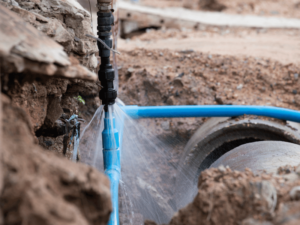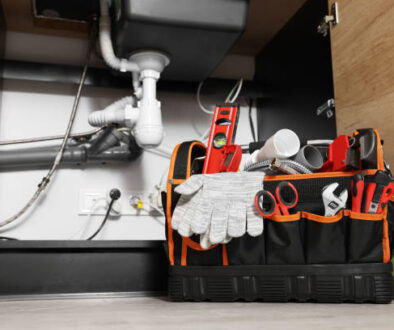5 Common Causes of Sewer Line Blockages and
How to Spot Them
Are you noticing a foul smell in your home but can’t find the culprit? You might be dealing with a sewer line blockage, something that can be a major inconvenience for homeowners. They can cause sewage backups, foul odors, and even structural damage if left untreated.
In this article, we’ll discuss the common causes of sewer line blockages and arm you with insights on how to spot them before they become a bigger problem.
Understanding Sewer Line Blockages
Sewer lines play a crucial role in carrying wastewater from your home to the main sewer system. A functional sewer line ensures proper drainage and prevents sewage backups, getting everything out and away from the home seamlessly. Like any well-oiled machine, it can fall victim to various factors that can lead to blockages, disrupting the flow of wastewater and causing plumbing issues. But fret not – by understanding the basics of sewer line blockages, you can take the necessary steps to prevent and resolve them.
The Importance of a Functional Sewer Line
A functional sewer line is essential for the proper functioning of your home’s plumbing system. It allows wastewater to be safely transported away from your property, preventing sewage backups, potential health risks, stinky toilets, and overflowing drains. A well-maintained sewer line also helps maintain the structural integrity of your property by preventing water damage and soil erosion.
Picture this: your sewer line is blocked, and there’s wastewater backing up into your sinks, tubs, toilets, and showers. The wastewater from your home has nowhere to go, and it starts backing up into your sinks, toilets, and showers. The foul smell permeates your entire house, making it unbearable to live in. Not only is this situation stinky, but it also poses serious health risks. Bacteria and other harmful pathogens present in sewage can contaminate your living space, creating a breeding ground for infections and diseases.
Now, picture a well-functioning sewer line. It efficiently carries wastewater away from your property, ensuring a clean and healthy living space. You don’t have to worry about sewage backups or their potential disruptions to your daily life. With your plumbing system in full working order, you can focus on other aspects of homeownership, barely stopping to think about the sewer line at all.
The Basics of Sewer Line Blockages
Sewer line blockages are typically the courtesy of foreign materials or objects obstructing the flow of wastewater through the pipes. These culprits range from invading tree roots to inappropriately disposed of non-degradable items.
Tree Roots
Tree roots are one of the most common causes of sewer line blockages. As trees grow, their thirsty roots stretch and expand, infiltrating sewer pipes in their search for water and nutrients. Sewer lines have both moisture and nutrients, making them the perfect environment for root growth. Over time, these roots can cause significant pipe damage or simple blockages that can develop into collapsed pipes or completely obstructed lines. These root-related blockages can be prevented with regular inspections and proactive measures like strategically planting trees away from your home.
It’s worth noting that certain tree species have root systems that threaten pipes more than others. Some trees, like willows and poplars, are notorious for their aggressive root growth and should be planted at a safe distance from sewer lines. On the other hand, trees with less invasive root systems, such as dogwoods or redbuds, may pose a lower risk.
Non-Degradable Items
Another common cause of sewer line blockages is the careless tossing of non-degradable items down the toilet. Items like baby wipes, sanitary products, diapers, and paper towels should never be flushed. These materials do not break down easily and can accumulate in the pipes, causing everything to come to a halt. The solution? Throw anything that’s not toilet paper away in trash bins – not the toilet. Make sure any children know this rule, too.
Kitchen Grease
Grease and fat buildup can also contribute to sewer line blockages. In their liquid form, they might seem harmless. But, when poured down the drain, grease and fat solidify, narrowing the passageway meant for wastewater. Over time, they can amass into a substantial plug, triggering bothersome clogs and backups. Make a habit of allowing greases to cool and solidify before throwing them in the trash, not down the drain. This includes fats that are solid at room temperature like bacon grease and group beef fat. Thinner oils like olive and canola oil are liquid at room temperature and can go down the drain.
Structural Damage to the Pipes
Aging pipes, corrosion, and shifting soil can all contribute to cracks or collapses in your pipes, blocking the flow of wastewater and even causing structural damage. Inspections by a professional plumber every 3-5 years can identify and address any structural issues before they cause major blockages.
During these inspections, plumbers use advanced techniques like video camera inspections to assess the condition of the pipes from within. This non-invasive method allows them to detect any signs of damage or deterioration without any extensive digging or excavation. Catching these issues early on avoids costly repairs and the shock of waking up to a smelly, backed-up sewer line.
Natural Disasters and Weather Conditions
Lastly, natural disasters and extreme weather can also wreak havoc on pipes and cause sewer line blockages. Heavy rains, floods, or earthquakes can damage the sewer infrastructure and contribute to the structural damage discussed above. While we can’t control these natural events, being aware of their potential impact on your sewer line can empower you to take swift action at the first sign of a problem.
In areas prone to heavy rainfall or flooding, having a backup plan is a good idea. This looks like installing a sump pump or a backwater valve to help prevent water from entering your sewer system and causing blockages during rainy seasons. Regular maintenance and inspections of these systems are essential, especially when you’re banking on their performance.
To recap, regular maintenance, such as sewer line inspections and cleaning, can help identify potential issues before they escalate. Proper waste disposal practices and mindful landscaping can also contribute to a smoothly functioning sewer line, ensuring the efficient removal of wastewater from your property.
Catch up on our latest posts:
Spotting the Signs of Sewer Line Blockages
You should be aware of what your home’s plumbing system looks and sounds like when it’s running properly. This way, you’ll notice when something’s awry and can spot potential issues. Sewer line blockages, caused by tree root intrusions, debris buildup, or even collapsed pipes, may show signs of trouble early on. Here’s how to spot them:
1. Unusual Noises from Your Drains
One of the first signs of a sewer line blockage is the presence of unusual noises coming from your drains. If you hear gurgling or bubbling sounds when water is draining, it could be the first hint of a blockage in the sewer line. These strange noises are caused by air getting trapped in the pipes, leading to an uneven water flow.
Don’t ignore these sounds! They could be a warning sign of a more serious issue. Call a plumber ASAP to investigate further and assess the situation. At the very least, they can provide the peace of mind that your system is okay.
2. Slow Drainage and Frequent Clogs
Are your sinks, toilets, or showers draining slower than usual or experiencing frequent clogs? This could very well signal a blockage in your sewer line. When wastewater can’t flow away from the home, it has nowhere else to go but back up into your fixtures.
Ignoring these signs can lead to escalating plumbing issues like sewage backups or worse – burst pipes. Contact a plumber immediately to pinpoint and resolve the blockage before it causes further damage.
3. Foul Odors Emanating from Drains
One of the most unpleasant and obvious signs of a sewer line blockage is foul odors emanating from your drains. This is a smell of trapped wastewater, and yes, it means something in your plumbing system is very wrong. If you notice persistent odors, especially in multiple drains, address the issue right away to prevent actual overflows and leaks.
These odors not only make your home uncomfortable but can also pose health risks. Sewage contains harmful bacteria and pathogens that aren’t safe to be around. For your and your family’s safety, call a plumber to inspect and resolve the blockage as soon as possible.
4. Changes in Your Lawn’s Appearance
Believe it or not, your lawn’s appearance can exhibit signs of a sewer line blockage. Sinkholes, wet spots, and overly lush patches of grass in your yard can indicate a blockage in the sewer line or other plumbing concerns. Blockages cause wastewater to seep into the ground, resulting in changes in your lawn’s moisture levels.
These changes can be particularly concerning – they not only affect the aesthetics of your yard but also indicate serious issues lurking below. It’s crucial to have your sewer line inspected by a professional plumber if you notice any of these outdoor changes.
Knowing the signs of a sewer line blockage can help you play your role in maintaining the integrity of your home’s plumbing system. By paying attention to unusual noises, slow drainage, foul odors, and changes in your lawn’s appearance, you can hopefully address any potential blockages while the problem is still small. Remember, when in doubt, call a professional. It will pay off in the long run.
Preventive Measures for Sewer Line Blockages
Regular Maintenance and Inspection
Regular maintenance and inspection of your sewer line can identify any potential issues before they develop into major blockages. Consider proactive measures like hydrojetting to help remove any debris or buildup in the pipes, keeping wastewater running smoothly and evenly.
Proper Disposal of Waste
Proper waste disposal is crucial in preventing sewer line blockages. Avoid pouring grease, fat, or oil down the drains. Dispose of them in sealed containers instead; you’ll see how they harden once they cool down. They do the same in your drains! Educate your kids about the importance of flushing only toilet paper. While flushable wipes are marketed as sewer line-safe, they’ve been known to cause serious blockages. Adopting these simple habits and protecting your home’s plumbing system!
Installing Root Barriers
If you have trees near your sewer line, root barriers can effectively prevent them from taking over your pipes. Root barriers prevent tree roots from infiltrating your pipes, but must be installed by a professional. Consulting with a professional landscaper can help you determine the best type of root barrier for your property and ensure proper, secure installation.
Protecting Your Home’s Sewer Line
In conclusion, understanding the common causes of sewer line blockages allows homeowners to spot early warning signs and avoid potential plumbing disasters. By taking preventive measures and addressing any issues at the first hint of trouble, you can ensure a smoothly functioning sewer line and avoid the costly and unsanitary alternative.
Remember, maintenance, proper waste disposal, and vigilance are the 3 ways to keep your sewer line clear and your home’s plumbing system in top shape.



